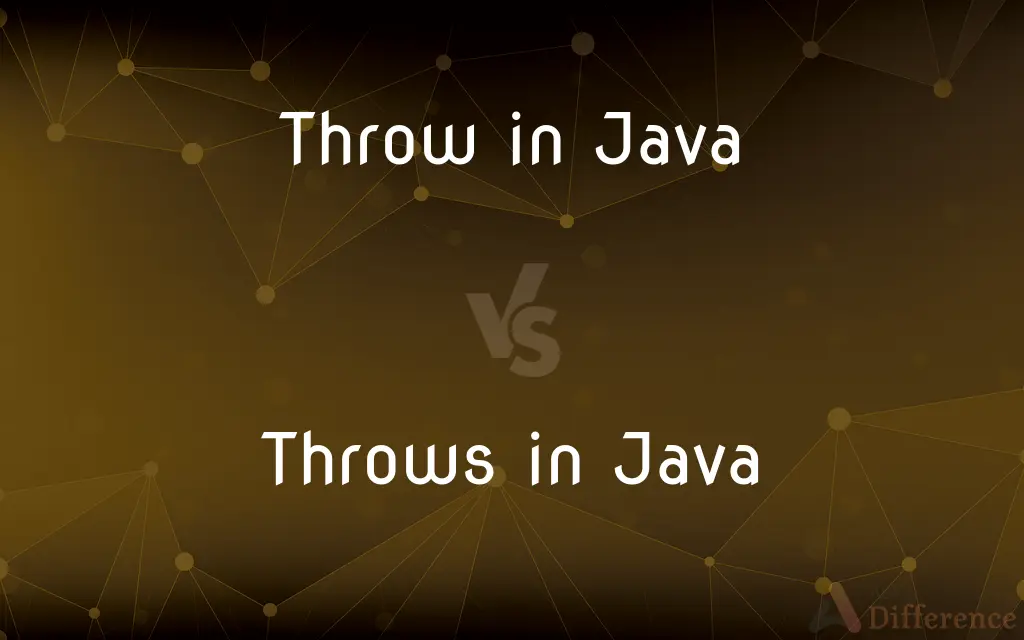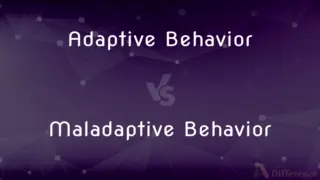Throw in Java vs. Throws in Java — What's the Difference?
By Tayyaba Rehman & Urooj Arif — Published on February 8, 2024
Throw in Java is used within a method to explicitly throw an exception, whereas Throws is used in a method's signature to indicate that the method might throw an exception, which must be handled or declared by the calling function.

Difference Between Throw in Java and Throws in Java
Table of Contents
ADVERTISEMENT
Key Differences
Throw in Java is a keyword used within a method to throw an exception explicitly. Throws in Java is a keyword used in the method signature to declare that the method might throw one or more exceptions.
When using throw, you are actively creating an exception object and throwing it. On the other hand, throws is used to signal that the method could potentially result in an exception being thrown, without actively throwing it.
Throw is used to handle exceptions at a granular level, allowing developers to control the flow of execution through exceptions. Conversely, throws is used to propagate exceptions to the caller of the method, letting them handle the exception.
With throw, only one exception at a time can be thrown. In contrast, with throws, a method can declare multiple exceptions that it might throw.
Throw is an actual operation that occurs at runtime and affects the program's flow. Throws, however, is a part of the method signature and serves as a warning mechanism during compilation.
ADVERTISEMENT
Comparison Chart
Usage Context
Inside a method or code block
In method declarations
Function
To explicitly throw a single exception
To declare possible exceptions a method might throw
Exception Handling
Used for actual throwing of exceptions
Signals potential exceptions to method callers
Number of Exceptions
Can throw only one exception at a time
Can declare multiple exceptions
Runtime vs Compile-time
Operational at runtime
Used as a warning during compilation
Compare with Definitions
Throw in Java
Throw triggers an exception explicitly.
Throw new IllegalArgumentException(Invalid input);
Throws in Java
Throws can list multiple exceptions in a method.
Public void saveFile() throws FileNotAccessibleException, SecurityException { ... }
Throw in Java
Throw is used for custom exception handling.
If (x < 0) throw new ArithmeticException(Negative value not allowed);
Throws in Java
Throws declares potential exceptions in a method signature.
Public void readFile() throws IOException { ... }
Throw in Java
Throw is used within methods or blocks.
If (user == null) throw new UserNotFoundException(User not found);
Throws in Java
Throws indicates what exceptions a method might propagate.
Public void connectToServer() throws NetworkException, TimeoutException { ... }
Throw in Java
Throw directs the program flow through exceptions.
If (data == null) throw new NullPointerException(Data is null);
Throws in Java
Throws alerts the caller of a method about possible exceptions.
Public void processData() throws DataFormatException, NullPointerException { ... }
Throw in Java
Throw initializes exception objects.
Throw new Exception(General error);
Throws in Java
Throws is used for exception declaration, not handling.
Public int divide(int a, int b) throws ArithmeticException { ... }
Common Curiosities
Can we throw multiple exceptions using throw?
No, throw can only throw one exception at a time.
Can throw be used without catch in Java?
Yes, throw can be used without catch, but the thrown exception must be handled elsewhere or declared in the method signature.
What is the purpose of throws in Java?
It declares that a method might throw certain exceptions.
Is throws mandatory for all exceptions in Java?
No, throws is not mandatory for unchecked exceptions (runtime exceptions).
What does throw do in Java?
It explicitly throws an exception in a method or code block.
Can a method have both throw and throws?
Yes, a method can use throw to throw an exception and throws to declare it.
Does throws guarantee that an exception will occur?
No, throws only declares the possibility of an exception.
How does throws help in exception handling?
Throws indicates to the caller of the method that they need to handle the declared exceptions.
Is it possible to throw an exception manually?
Yes, using the throw keyword, you can throw an exception manually.
What types of exceptions need to be declared with throws?
Checked exceptions need to be declared with throws.
Can throws be used with constructors?
Yes, constructors in Java can also use throws.
Does throw affect the program flow?
Yes, throw immediately transfers control to the nearest catch block or alters the method flow.
What happens if a thrown exception is not handled?
The program will terminate abruptly if a thrown exception is not properly handled.
Can throws be used for unchecked exceptions?
Yes, but it's not mandatory to declare unchecked exceptions with throws.
What is the difference between throw and throws in error handling?
Throw is used to explicitly throw an exception, while throws is used to declare that a method might throw exceptions.
Share Your Discovery

Previous Comparison
Adaptive Behavior vs. Maladaptive Behavior
Next Comparison
Jackie Chan vs. Bruce LeeAuthor Spotlight
Written by
Tayyaba RehmanTayyaba Rehman is a distinguished writer, currently serving as a primary contributor to askdifference.com. As a researcher in semantics and etymology, Tayyaba's passion for the complexity of languages and their distinctions has found a perfect home on the platform. Tayyaba delves into the intricacies of language, distinguishing between commonly confused words and phrases, thereby providing clarity for readers worldwide.
Co-written by
Urooj ArifUrooj is a skilled content writer at Ask Difference, known for her exceptional ability to simplify complex topics into engaging and informative content. With a passion for research and a flair for clear, concise writing, she consistently delivers articles that resonate with our diverse audience.
















































